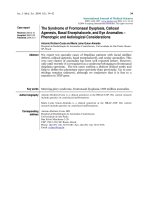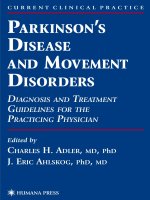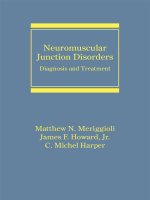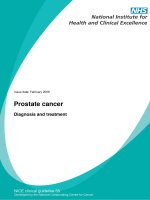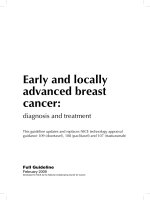Wills eye manual office and emergency room diagnosis and treatm
Bạn đang xem bản rút gọn của tài liệu. Xem và tải ngay bản đầy đủ của tài liệu tại đây (10.83 MB, 491 trang )
THE WILLS EYE MANUAL
Office and Emergency Room
Diagnosis and Treatment of Eye Disease
SIXTH EDITION
LWBK1000-FM.indd i
23/12/11 8:33 PM
LWBK1000-FM.indd ii
23/12/11 8:33 PM
THE WILLS EYE MANUAL
Office and Emergency Room
Diagnosis and Treatment of Eye Disease
SIX TH EDITION
EDITORS
Adam T. Gerstenblith
Michael P. Rabinowitz
ASSOCIATE EDITORS
Behin I. Barahimi
Christopher M. Fecarotta
FOUNDING EDITORS
Mark A. Friedberg
Christopher J. Rapuano
LWBK1000-FM.indd iii
23/12/11 8:33 PM
Senior Executive Editor: Jonathan W. Pine, Jr.
Senior Product Manager: Emilie Moyer
Vendor Manager: Alicia Jackson
Senior Manufacturing Manager: Benjamin Rivera
Marketing Manager: Lisa Lawrence
Art Director: Doug Smock
Production Services: Aptara, Inc.
© 2012 by LIPPINCOTT WILLIAMS & WILKINS, a Wolters Kluwer business
Two Commerce Square
2001 Market Street
Philadelphia, PA 19103 USA
LWW.com
Fifth edition, © Lippincott Williams & Wilkins, 2008
Fourth edition, © Lippincott Williams & Wilkins, 2004
Third edition, © Lippincott Williams & Wilkins, 1999
Second edition, © Lippincott Williams & Wilkins, 1994
First edition, © Lippincott-Raven, 1990
All rights reserved. This book is protected by copyright. No part of this book may be reproduced in
any form by any means, including photocopying, or utilized by any information storage and retrieval
system without written permission from the copyright owner, except for brief quotations embodied
in critical articles and reviews. Materials appearing in this book prepared by individuals as part of
their official duties as U.S. government employees are not covered by the above-mentioned copyright.
Printed in China
Library of Congress Cataloging-in-Publication Data
available upon request
ISBN 13: 978-1-4511-0938-2
ISBN 10: 1-4511-0938-5
Care has been taken to confirm the accuracy of the information presented and to describe generally
accepted practices. However, the authors, editors, and publisher are not responsible for errors or omissions or for any consequences from application of the information in this book and make no warranty, expressed or implied, with respect to the currency, completeness, or accuracy of the contents
of the publication. Application of the information in a particular situation remains the professional
responsibility of the practitioner.
The authors, editors, and publisher have exerted every effort to ensure that drug selection and
dosage set forth in this text are in accordance with current recommendations and practice at the time
of publication. However, in view of ongoing research, changes in government regulations, and the
constant flow of information relating to drug therapy and drug reactions, the reader is urged to check
the package insert for each drug for any change in indications and dosage and for added warnings and
precautions. This is particularly important when the recommended agent is a new or infrequently
employed drug.
Some drugs and medical devices presented in the publication have Food and Drug Administration
(FDA) clearance for limited use in restricted research settings. It is the responsibility of the health care
provider to ascertain the FDA status of each drug or device planned for use in their clinical practice.
To purchase additional copies of this book, call our customer service department at (800) 638-3030 or
fax orders to (301) 223-2320. International customers should call (301) 223-2300.
Visit Lippincott Williams & Wilkins on the Internet at LWW.com. Lippincott Williams & Wilkins
customer service representatives are available from 8:30 am to 6 pm, EST.
10 9 8 7 6 5 4 3 2 1
LWBK1000-FM.indd iv
23/12/11 11:06 PM
CONSULTANTS
Contributors
CONTRIBUTORS TO THE SIXTH EDITION
Fatima K. Ahmad, M.D.
Christopher J. Brady, M.D.
Meg R. Gerstenblith, M.D.
Katherine G. Gold, M.D.
Sebastian B. Heersink, M.D.
Suzanne K. Jadico, M.D.
Brandon B. Johnson, M.D.
Jennifer H. Kim, M.D.
Amanda E. Matthews, M.D.
Melissa D. Neuwelt, M.D.
Anne M. Nguyen, M.D.
Linda H. Ohsie, M.D.
Kristina Yi-Hwa Pao, M.D.
Mindy R. Rabinowitz, M.D.
Vikram J. Setlur, M.D.
Gary Shienbaum, M.D.
Eileen Wang, M.D.
Douglas M. Wisner, M.D.
CONTRIBUTORS TO THE FIFTH EDITION
TEXT CONTRIBUTORS
Paul S. Baker, M.D.
Shaleen L. Belani, M.D.
Shawn Chhabra, M.D.
John M. Cropsey, M.D.
Emily A. DeCarlo, M.D.
Justis P. Ehlers, M.D.
Gregory L. Fenton, M.D.
David Fintak, M.D.
Robert E. Fintelmann, M.D.
Nicole R. Fram, M.D.
Susan M. Gordon, M.D.
Omesh P. Gupta, M.D., M.B.A.
Eliza N. Hoskins, M.D.
Dara Khalatbari, M.D.
Bhairavi V. Kharod, M.D.
Matthew R. Kirk, M.D.
Andrew Lam, M.D.
Katherine A. Lane, M.D.
Michael A. Malstrom, M.D.
Chrishonda C. McCoy, M.D.
Jesse B. McKey, M.D.
Maria P. McNeill, M.D.
Joselitio S. Navaleza, M.D.
Avni H. Patel, M.D.
Chirag P. Shah, M.D., M.P.H.
Heather N. Shelsta, M.D.
Bradley T. Smith, M.D.
Vikas Tewari, M.D.
Garth J. Willis, M.D.
Allison P. Young, M.D.
PHOTO CONTRIBUTORS
Elizabeth L. Affel, M.S., R.D.M.S.
Robert S. Bailey, Jr., M.D.
William E. Benson, M.D.
Jurij R. Bilyk, M.D.
Elisabeth J. Cohen, M.D.
Justis P. Ehlers, M.D.
Alan R. Forman, M.D.
Scott M. Goldstein, M.D.
Kammi B. Gunton, M.D.
Becky Killian
Donelson R. Manley, M.D.
Julia Monsonego
Christopher J. Rapuano, M.D.
Peter J. Savino, M.D.
Bruce M. Schnall, M.D.
Robert C. Sergott, M.D.
Chirag P. Shah, M.D., M.P.H.
Heather N. Shelsta, M.D.
Carol L. Shields, M.D.
Jerry A. Shields, M.D.
George L. Spaeth, M.D.
William Tasman, M.D.
v
LWBK1000-FM.indd v
23/12/11 8:33 PM
vi
C O N T R IB U TOR S
MEDICAL ILLUSTRATOR
Paul Schiffmacher
CONTRIBUTORS TO THE FOURTH EDITION
Seema Aggarwal, M.D.
Edward H. Bedrossian, Jr., M.D.
Brian C. Bigler, M.D.
Vatinee Y. Bunya, M.D.
Christine Buono, M.D.
Jacqueline R. Carrasco, M.D.
Sandra Y. Cho, M.D.
Carolyn A. Cutney, M.D.
Brian D. Dudenhoefer, M.D.
John A. Epstein, M.D.
Colleen P. Halfpenny, M.D.
ThucAnh T. Ho, M.D.
Stephen S. Hwang, M.D.
Kunal D. Kantikar, M.D.
Derek Y. Kunimoto, M.D.
R. Gary Lane, M.D.
Henry C. Lee, M.D.
Mimi Liu, M.D.
Mary S. Makar, M.D.
Anson T. Miedel, M.D.
Parveen K. Nagra, M.D.
Michael A. Negrey, M.D.
Heather A. Nesti, M.D.
Vasudha A. Panday, M.D.
Nicholas A. Pefkaros, M.D.
Robert Sambursky, M.D.
Daniel E. Shapiro, M.D.
Derrick W. Shindler, M.D.
CONTRIBUTORS TO THE THIRD EDITION
Christine W. Chung, M.D.
Brian P. Connolly, M.D.
Vincent A. Deramo, M.D.
Kammi B. Gunton, M.D.
Mark R. Miller, M.D.
Ralph E. Oursler III, M.D.
Mark F. Pyfer, M.D.
Douglas J. Rhee, M.D.
Jay C. Rudd, M.D.
Brian M. Sucheski, M.D.
MEDICAL ILLUSTRATOR
Marlon Maus, M.D.
LWBK1000-FM.indd vi
CONTRIBUTORS TO THE SECOND EDITION
Mark C. Austin, M.D.
Jerry R. Blair, M.D.
Benjamin Chang, M.D.
Mary Ellen Cullom, M.D.
R. Douglas Cullom, Jr., M.D.
Jack Dugan, M.D.
Forest J. Ellis, M.D.
C. Byron Faulkner, M.D.
Mary Elizabeth Gallivan, M.D.
J. William Harbour, M.D.
Paul M. Herring, M.D.
Allen C. Ho, M.D.
Carol J. Hoffman, M.D.
Thomas I. Margolis, M.D.
Mark L. Mayo, M.D.
Michele A. Miano, M.D.
Wynne A. Morley, M.D.
Timothy J. O’Brien, M.D.
Florentino E. Palmon, M.D.
William B. Phillips, M.D.
Tony Pruthi, M.D.
Carl D. Regillo, M.D.
Scott H. Smith, M.D.
Mark R. Stokes, M.D.
Janine G. Tabas, M.D.
John R. Trible, M.D.
Christopher Williams, M.D.
MEDICAL ILLUSTRATOR
Neal H. Atebara, M.D.
CONTRIBUTORS TO THE FIRST EDITION
Melissa M. Brown, M.D.
Catharine J. Crockett, M.D.
Bret L. Fisher, M.D.
Patrick M. Flaharty, M.D.
Mark A. Friedberg, M.D.
James T. Handa, M.D.
Victor A. Holmes, M.D.
Bruce J. Keyser, M.D.
Ronald L. McKey, M.D.
Christopher J. Rapuano, M.D.
Paul A. Raskauskas, M.D.
Eric P. Suan, M.D.
MEDICAL ILLUSTRATOR
Marlon Maus, M.D.
23/12/11 8:33 PM
Consultants
CORNEA
MAJOR CONSULTANT
Christopher J. Rapuano, M.D.
CONSULTANTS
Brandon D. Ayers, M.D.
Elisabeth J. Cohen, M.D.
Brad H. Feldman, M.D.
Kristin M. Hammersmith, M.D.
Sadeer B. Hannush, M.D.
Irving M. Raber, M.D.
GLAUCOMA
MAJOR CONSULTANTS
L. Jay Katz, M.D.
George L. Spaeth, M.D.
CONSULTANTS
Mary J. Cox, M.D.
Scott J. Fudemberg, M.D.
Anand V. Mantravadi, M.D.
Marlene R. Moster, M.D.
Jonathan S. Myers, M.D.
Tara H. Uhler, M.D.
NEURO-OPHTHALMOLOGY
CONSULTANTS
Jennifer K. Hall, M.D.
Mark L. Moster, M.D
Peter J. Savino, M.D.
Robert C. Sergott, M.D.
OCULOPLASTICS
MAJOR CONSULTANTS
Jurij R. Bilyk, M.D.
Jacqueline R. Carrasco, M.D.
Robert B. Penne, M.D.
Mary A. Stefanyszyn, M.D.
CONSULTANTS
Edward H. Bedrossian, Jr., M.D.
Joseph C. Flanagan, M.D.
Scott M. Goldstein, M.D.
Ann P. Murchison, M.D., M.P.H.
ONCOLOGY
MAJOR CONSULTANTS
Carol L. Shields, M.D.
Jerry A. Shields, M.D.
CONSULTANTS
Sara A. Lally, M.D.
Arman Mashayekhi, M.D.
PEDIATRICS
MAJOR CONSULTANT
Alex V. Levin, M.D.
CONSULTANTS
Brian J. Forbes, M.D.
Kammi B. Gunton, M.D.
Sharon S. Lehman, M.D.
Leonard B. Nelson, M.D.
Jonathan H. Salvin, M.D.
Bruce M. Schnall, M.D.
Barry N. Wasserman, M.D.
RETINA
MAJOR CONSULTANTS
William E. Benson, M.D.
Sunir J. Garg, M.D.
Jason Hsu, M.D.
William Tasman, M.D.
CONSULTANTS
Mitchell S. Fineman, M.D.
Omesh P. Gupta, M.D., M.B.A.
Julia A. Haller, M.D.
vii
LWBK1000-FM.indd vii
23/12/11 8:33 PM
viii
C O N S U LTA NT S
Allen C. Ho, M.D.
Richard S. Kaiser, M.D.
Joseph I. Maguire, M.D.
Carl D. Regillo, M.D.
Marc J. Spirn, M.D.
James F. Vander, M.D.
INFECTIOUS DISEASE
CONSULTANT
Joseph A. DeSimone, Jr., M.D.
RADIOLOGY
CONSULTANT
Adam E. Flanders, M.D.
VISUAL PHYSIOLOGY
CONSULTANTS
Elizabeth L. Affel, M.S., R.D.M.S.
Julia Monsonego, C.R.A.
FELLOW CONSULTANTS
PATHOLOGY
CONSULTANT
Ralph C. Eagle, Jr., M.D.
GENERAL
CONSULTANTS
Michael A. DellaVecchia, M.D.
Alan R. Forman, M.D.
Edward A. Jaeger, M.D.
Bruce J. Markovitz, M.D.
LWBK1000-FM.indd viii
F. Char DeCroos, M.D.
Darrell E. Baskin, M.D.
Allen Chiang, M.D.
Paul B. Johnson, M.D.
Nikolas J.S. London, M.D
Rajiv E. Shah, M.D.
Chirag P. Shah, M.D., M.P.H.
Andre J. Witkin, M.D.
Vladimir S. Yakopson, M.D.
MEDICAL ILLUSTRATOR
Paul Schiffmacher
23/12/11 8:33 PM
Foreword
Cornea
4
Wills Eye celebrated its 175th anniversary in 2009 and the Retina
Service its 50th anniversary in 2010. Hard to believe. Now, in 2012,
we are celebrating the sixth edition of The Wills Eye Manual. Conceived by Mark Friedberg and Christopher Rapuano when they were
residents in 1990, the manual has had a great track record. To date,
150,000 copies have been sold, and it has been translated into ten
languages. It is also now helping to disseminate educational information to physicians in developing countries, especially through the
American Academy of Ophthalmology’s Ophthalmic News & Education (ONE) network.
Adam Gerstenblith and Michael Rabinowitz, the editors of the
sixth edition, have been extremely efficient in revising this latest volume. The previous edition, published in 2007, was the first to have
illustrations enhancing the descriptions of various conditions, and
the new edition includes additional and revised illustrations, where
appropriate, as well as the latest information. In the past few years
ophthalmology has taken giant steps forward, notably in the management of wet macular degeneration, use of computer chips for retinal function, the role of stem cells, and exponential progress in gene
identification of disease entities.
Although tomorrow’s future will soon be yesterday’s history, we
continue to learn more about the original Wills family. Thanks to the
National Park Service, the deed to the original Wills house and grocery (which was located behind the house) between Second and Third
on Chestnut has surfaced. The most interesting fact we learned was
that James Sr. and Hannah Wills bought the property from Benjamin
Rush, the renowned physician of the day. It was purchased for 700
pounds gold. Rush was a signer of the Declaration of Independence,
and because of his fame, President Thomas Jefferson suggested that
Meriwether Lewis pay him a visit before Lewis and William Clark left
in 1804–1806 to explore the land acquired in the Louisiana Purchase.
So, Wills with its colorful history has grown up and continues to
thrive. I am confident that it will continue to contribute new and
exciting advances, some not yet even conceived.
William Tasman, M.D.
ix
LWBK1000-FM.indd ix
23/12/11 8:33 PM
LWBK1000-FM.indd x
23/12/11 8:33 PM
Preface
We are proud to present the Sixth Edition of The Wills Eye Manual.
This edition builds upon the hard work of all previous contributors, and would not be possible without the collaborative effort of
the Wills Eye Institute residents and faculty. Our goal is to continue
to provide the most accurate and current information regarding the
office and emergency room diagnosis, management, and treatment of
ophthalmic disease.
The Sixth Edition includes the results of some of the most recent
major clinical trials, including those relating to the care of patients with
macular degeneration and retinal vein occlusion. Changing trends
in the management of a variety of ophthalmic pathology, including
orbital fractures, eyelid lacerations, strabismus, amblyopia, and ocular
malignancies, are reflected in this newest edition. Many new highdefinition photographs of external, anterior segment, and posterior
segment disease processes have been added, including fundus photos of Sturge–Weber Syndrome, Wyburn-Mason Syndrome, and solar
retinopathy. We have also updated the imaging modalities highlighted
in the previous edition, with special attention to optical coherence
tomography, magnetic resonance imaging, computed tomography,
and ultrasound biomicroscopy. In addition, many updated chapters
were expanded to include new, clinically relevant, topics.
With the addition of more illustrations and topics, it was necessary
to streamline various sections. To that end, and with feedback from
our readers, we have minimized redundancy throughout the manual
and removed information more commonly found in other references.
We hope you continue to find the Sixth Edition of The Wills Eye
Manual a fast, easy-to-use guide to managing ophthalmic disease.
Adam T. Gerstenblith, M.D.
Michael P. Rabinowitz, M.D.
xi
LWBK1000-FM.indd xi
23/12/11 8:33 PM
LWBK1000-FM.indd xii
23/12/11 8:33 PM
Preface to the
First Edition
Our goal has been to produce a concise book, providing essential
diagnostic tips and specific therapeutic information pertaining to eye
disease. We realized the need for this book while managing emergency room patients at one of the largest and busiest eye hospitals in
the country. Until now, reliable information could only be obtained
in unwieldy textbooks or inaccessible journals.
As residents at Wills Eye Hospital we have benefited from the input
of some of the world-renowned ophthalmic experts in writing this
book. More importantly, we are aware of the questions that the ophthalmology resident, the attending ophthalmologist, and the emergency room physician (not trained in ophthalmology) want answered
immediately.
The book is written for the eye care provider who, in the midst of
evaluating an eye problem, needs quick access to additional information. We try to be as specific as possible, describing the therapeutic
modalities used at our institution. Many of these recommendations
are, therefore, not the only manner in which to treat a particular disorder, but indicate personal preference. They are guidelines, not rules.
Because of the forever changing wealth of ophthalmic knowledge,
omissions and errors are possible, particularly with regard to management. Drug dosages have been checked carefully, but the physician is
urged to check the Physicians’ Desk Reference or Facts and Comparisons
when prescribing unfamiliar medications. Not all contraindications
and side effects are described.
We feel this book will make a welcome companion to the many
physicians involved with treating eye problems. It is everything you
wanted to know and nothing more.
Christopher J. Rapuano, M.D.
Mark A. Friedberg, M.D.
xiii
LWBK1000-FM.indd xiii
23/12/11 8:33 PM
LWBK1000-FM.indd xiv
23/12/11 8:33 PM
Contents
Contributors v
Consultants vii
Foreword ix
Preface xi
Preface to the First Edition
3.19
3.20
CHAPTER 4
xiii
Cornea
CHAPTER 1
Differential Diagnosis of
Ocular Symptoms
1
CHAPTER 2
6
Differential Diagnosis of Ocular Signs
4.1
4.2
4.3
4.4
4.5
4.6
4.7
4.8
CHAPTER 3
Trauma
Purtscher Retinopathy 52
Shaken Baby Syndrome/Inflicted
Childhood Neurotrauma 53
13
3.1 Chemical Burn 13
3.2 Corneal Abrasion 16
3.3 Corneal and Conjunctival
Foreign Bodies 17
3.4 Conjunctival Laceration 19
3.5 Traumatic Iritis 20
3.6 Hyphema and Microhyphema 21
3.7 Iridodialysis/Cyclodialysis 25
3.8 Eyelid Laceration 26
3.9 Orbital Blow-Out Fracture 32
3.10 Traumatic Retrobulbar
Hemorrhage 35
3.11 Traumatic Optic Neuropathy 40
3.12 Intraorbital Foreign Body 42
3.13 Corneal Laceration 44
3.14 Ruptured Globe and Penetrating
Ocular Injury 46
3.15 Intraocular Foreign Body 48
3.16 Commotio Retinae 49
3.17 Traumatic Choroidal Rupture 50
3.18 Chorioretinitis Sclopetaria 51
4.9
4.10
4.11
4.12
4.13
4.14
4.15
4.16
4.17
4.18
4.19
4.20
4.21
4.22
4.23
4.24
4.25
4.26
4.27
55
Superficial Punctate Keratopathy 55
Recurrent Corneal Erosion 57
Dry-Eye Syndrome 59
Filamentary Keratopathy 61
Exposure Keratopathy 62
Neurotrophic Keratopathy 63
Thermal/Ultraviolet
Keratopathy 64
Thygeson Superficial Punctate
Keratopathy 65
Pterygium/Pinguecula 66
Band Keratopathy 67
Bacterial Keratitis 69
Fungal Keratitis 73
Acanthamoeba Keratitis 75
Crystalline Keratopathy 76
Herpes Simplex Virus 77
Herpes Zoster Ophthalmicus/
Varicella Zoster Virus 81
Ocular Vaccinia 85
Interstitial Keratitis 86
Staphylococcal
Hypersensitivity 88
Phlyctenulosis 89
Contact Lens-Related Problems 90
Contact Lens-Induced Giant
Papillary Conjunctivitis 94
Peripheral Corneal
Thinning/Ulceration 95
Dellen 98
Keratoconus 98
Corneal Dystrophies 100
Fuchs Endothelial Dystrophy 102
xv
LWBK1000-FM.indd xv
23/12/11 8:33 PM
xvi
CONTENTS
4.28
Aphakic Bullous Keratopathy/
Pseudophakic Bullous
Keratopathy 103
4.29 Corneal Graft Rejection 104
4.30 Corneal Refractive Surgery
Complications 105
7.5
7.6
7.7
CHAPTER 8
Pediatrics
CHAPTER 5
Conjunctiva/Sclera/Iris/
External Disease
Traumatic Orbital Disease 173
Lacrimal Gland Mass/Chronic
Dacryoadenitis 174
Miscellaneous Orbital Diseases 176
110
5.1
5.2
5.3
Acute Conjunctivitis 110
Chronic Conjunctivitis 116
Parinaud Oculoglandular
Conjunctivitis 118
5.4 Superior Limbic
Keratoconjunctivitis 119
5.5 Subconjunctival Hemorrhage 120
5.6 Episcleritis 121
5.7 Scleritis 122
5.8 Blepharitis/Meibomitis 125
5.9 Ocular Rosacea 126
5.10 Ocular Cicatricial Pemphigoid 127
5.11 Contact Dermatitis 129
5.12 Conjunctival Tumors 129
5.13 Malignant Melanoma of the Iris 133
8.1
8.2
8.3
8.4
8.5
8.6
8.7
8.8
8.9
8.10
8.11
8.12
8.13
8.14
177
Leukocoria 177
Retinopathy of Prematurity 179
Familial Exudative
Vitreoretinopathy 182
Esodeviations in Children 183
Exodeviations in Children 186
Strabismus Syndromes 188
Amblyopia 189
Congenital Cataract 191
Ophthalmia Neonatorum
(Newborn Conjunctivitis) 193
Congenital Nasolacrimal Duct
Obstruction 195
Congenital/Infantile
Glaucoma 196
Developmental Anterior Segment
and Lens Anomalies/Dysgenesis 198
Congenital Ptosis 200
The Bilaterally Blind Infant 201
CHAPTER 6
Eyelid
135
Glaucoma
6.1
6.2
6.3
6.4
6.5
6.6
6.7
6.8
6.9
Ptosis 135
Chalazion/Hordeolum 137
Ectropion 139
Entropion 140
Trichiasis 140
Floppy Eyelid Syndrome 141
Blepharospasm 142
Canaliculitis 143
Dacryocystitis/Inflammation of
the Lacrimal Sac 144
6.10 Preseptal Cellulitis 146
6.11 Malignant Tumors of
the Eyelid 149
9.1
9.2
9.3
9.4
9.5
9.6
9.7
9.8
CHAPTER 7
Orbit
153
7.1 Orbital Disease 153
7.2 Inflammatory Orbital Disease 154
7.3 Infectious Orbital Disease 159
7.4 Orbital Tumors 165
LWBK1000-FM.indd xvi
CHAPTER 9
9.9
9.10
9.11
9.12
204
Primary Open-Angle Glaucoma 204
Low-Pressure Primary OpenAngle Glaucoma (Normal Pressure
Glaucoma) 211
Ocular Hypertension 212
Acute Angle-Closure Glaucoma 213
Chronic Angle-Closure
Glaucoma 216
Angle-Recession Glaucoma 217
Inflammatory Open-Angle
Glaucoma 218
Glaucomatocyclitic Crisis/Posner–
Schlossman Syndrome 220
Steroid-Response Glaucoma 221
Pigment Dispersion Syndrome/
Pigmentary Glaucoma 222
Pseudoexfoliation Syndrome/
Exfoliative Glaucoma 224
Lens-Induced (Phacogenic)
Glaucoma 226
23/12/11 8:33 PM
CONTENTS
9.13
9.14
9.15
Plateau Iris 229
Neovascular Glaucoma 230
Iridocorneal Endothelial
Syndrome 233
9.16 Postoperative Glaucoma 234
9.17 Aqueous Misdirection Syndrome/
Malignant Glaucoma 236
9.18 Postoperative Complications of
Glaucoma Surgery 237
9.19 Blebitis 240
CHAPTER 10
Neuro-Ophthalmology
242
10.1 Anisocoria 242
10.2 Horner Syndrome 244
10.3 Argyll Robertson Pupils 246
10.4 Adie (Tonic) Pupil 247
10.5 Isolated Third Nerve Palsy 248
10.6 Aberrant Regeneration
of the Third Nerve 251
10.7 Isolated Fourth Nerve Palsy 252
10.8 Isolated Sixth Nerve Palsy 254
10.9 Isolated Seventh Nerve Palsy 256
10.10 Cavernous Sinus And Associated
Syndromes (Multiple Ocular
Motor Nerve Palsies) 259
10.11 Myasthenia Gravis 263
10.12 Chronic Progressive External
Ophthalmoplegia 266
10.13 Internuclear Ophthalmoplegia 267
10.14 Optic Neuritis 268
10.15 Papilledema 271
10.16 Idiopathic Intracranial
Hypertension/Pseudotumor
Cerebri 273
10.17 Arteritic Ischemic Optic Neuropathy
(Giant Cell Arteritis) 274
10.18 Nonarteritic Ischemic
Optic Neuropathy 276
10.19 Posterior Ischemic
Optic Neuropathy 277
10.20 Miscellaneous Optic
Neuropathies 278
10.21 Nystagmus 280
10.22 Transient Visual Loss/Amaurosis
Fugax 283
10.23 Vertebrobasilar Artery
Insufficiency 284
10.24 Cortical Blindness 285
10.25 Nonphysiologic Visual Loss 286
LWBK1000-FM.indd xvii
10.26 Headache 287
10.27 Migraine 289
10.28 Cluster Headache
xvii
291
CHAPTER 11
Retina
11.1
11.2
11.3
11.4
11.5
11.6
11.7
11.8
11.9
11.10
11.11
11.12
11.13
11.14
11.15
11.16
11.17
11.18
11.19
11.20
11.21
11.22
11.23
11.24
11.25
11.26
11.27
11.28
11.29
11.30
11.31
293
Posterior Vitreous Detachment 293
Retinal Break 294
Retinal Detachment 295
Retinoschisis 298
Cotton–Wool Spot 300
Central Retinal Artery Occlusion 302
Branch Retinal Artery Occlusion 303
Central Retinal Vein Occlusion 304
Branch Retinal Vein Occlusion 307
Hypertensive Retinopathy 308
Ocular Ischemic Syndrome/Carotid
Occlusive Disease 309
Diabetic Retinopathy 310
Vitreous Hemorrhage 316
Cystoid Macular Edema 318
Central Serous
Chorioretinopathy 320
Nonexudative (Dry) Age-Related
Macular Degeneration 322
Neovascular or Exudative (Wet) AgeRelated Macular Degeneration 324
Idiopathic Polypoidal Choroidal
Vasculopathy (Posterior Uveal
Bleeding Syndrome) 326
Retinal Arterial Macroaneurysm 327
Sickle Cell Disease (Including Sickle
Cell Anemia, Sickle Trait) 328
Valsalva Retinopathy 330
High Myopia 331
Angioid Streaks 332
Ocular Histoplasmosis 334
Macular Hole 336
Epiretinal Membrane (Macular Pucker,
Surface-Wrinkling Retinopathy,
Cellophane Maculopathy) 338
Choroidal Effusion/
Detachment 339
Retinitis Pigmentosa and Inherited
Chorioretinal Dystrophies 341
Cone Dystrophies 345
Stargardt Disease (Fundus
Flavimaculatus) 346
Best Disease (Vitelliform Macular
Dystrophy) 348
23/12/11 8:33 PM
xviii
CONTENTS
11.32 Chloroquine/Hydroxychloroquine
Toxicity 349
11.33 Crystalline Retinopathy 350
11.34 Optic Pit 352
11.35 Solar Retinopathy 353
11.36 Choroidal Nevus and Malignant
Melanoma of the Choroid 354
CHAPTER 12
Uveitis
12.1
12.2
12.3
12.4
12.5
12.6
12.7
12.8
12.9
12.10
12.11
12.12
12.13
12.14
12.15
12.16
12.17
12.18
358
Anterior Uveitis (Iritis/
Iridocyclitis) 358
Intermediate Uveitis 364
Posterior Uveitis 365
Human Leukocyte Antigen (HLA)–
B27–Associated Uveitis 369
Toxoplasmosis 369
Sarcoidosis 372
BehÇet Disease 374
Acute Retinal Necrosis (ARN) 375
Cytomegalovirus Retinitis 377
Noninfectious Retinal
Microvasculopathy/HIV
Retinopathy 380
Vogt–Koyanagi–Harada
Syndrome 380
Syphilis 382
Postoperative Endophthalmitis 384
Chronic Postoperative Uveitis 387
Traumatic Endophthalmitis 388
Endogenous Bacterial
Endophthalmitis 389
Candida Retinitis/Uveitis/
Endophthalmitis 391
Sympathetic Ophthalmia 392
CHAPTER 13
General Ophthalmic Problems
13.1
13.2
13.3
13.4
13.5
13.6
394
Acquired Cataract 394
Pregnancy 396
Lyme Disease 397
Convergence Insufficiency 398
Accommodative Spasm 399
Stevens–Johnson Syndrome
(Erythema Multiforme Major) 400
13.7 Vitamin A Deficiency 402
13.8 Albinism 403
13.9 Wilson Disease 404
LWBK1000-FM.indd xviii
13.10 Subluxed or Dislocated
Crystalline Lens 405
13.11 Hypotony Syndrome 407
13.12 Blind, Painful Eye 409
13.13 Phakomatoses 410
CHAPTER 14
Imaging Modalities in
Ophthalmology
14.1
14.2
14.3
14.4
14.5
14.6
14.7
14.8
14.9
14.10
14.11
14.12
14.13
14.14
14.15
14.16
416
Plain Films 416
Computed Tomography 416
Magnetic Resonance Imaging 418
Magnetic Resonance
Angiography 420
Magnetic Resonance
Venography 421
Cerebral Arteriography 421
Nuclear Medicine 422
Ophthalmic Ultrasonography 422
Photographic Studies 424
Intravenous Fluorescein
Angiography 425
Indocyanine Green
Angiography 426
Optical Coherence Tomography 427
Confocal Scanning Laser
Ophthalmoscopy 428
Confocal Biomicroscopy 428
Corneal Topography & Tomography
Description 428
Dacryocystography 429
Appendices
Appendix 1
Appendix 2
Appendix 3
Appendix 4
Appendix 5
Appendix 6
Appendix 7
Appendix 8
Appendix 9
430
Dilating Drops 430
Tetanus Prophylaxis 431
Cover/Uncover and Alternate
Cover Tests 431
Amsler Grid 432
Seidel Test to Detect a Wound
Leak 433
Forced-Duction Test and Active
Force Generation Test 433
Technique for Diagnostic
Probing and Irrigation of The
Lacrimal System 435
Corneal Culture
Procedure 435
Fortified Topical Antibiotics/
Antifungals 437
23/12/11 8:33 PM
CONTENTS
Appendix 10 Technique for Retrobulbar/
Subtenon/Subconjunctival
Injections 438
Appendix 11 Intravitreal Tap and
Inject 439
Appendix 12 Intravitreal Antibiotics 440
Appendix 13 Anterior Chamber
Paracentesis 440
Appendix 14 Angle Classification
441
LWBK1000-FM.indd xix
xix
Appendix 15 Yag Laser Peripheral
Iridotomy 444
Appendix 16 YAG Capsulotomy 445
Ophthalmic Acronyms and
Abbreviations
Index
446
451
23/12/11 8:33 PM
LWBK1000-FM.indd xx
23/12/11 8:33 PM
Differential
Diagnosis of
Ocular Symptoms
BURNING
More Common. Blepharitis, meibomitis, dryeye syndrome, conjunctivitis (infectious, allergic, mechanical, chemical).
Less Common. Corneal defects (usually
marked by fluorescein staining of the cornea),
inflamed pterygium or pinguecula, episcleritis,
superior limbic keratoconjunctivitis, ocular
toxicity (medication, makeup, contact lens
solutions), contact lens-related problems.
CROSSED EYES IN CHILDREN
See 8.4, Esodeviations in Children (eyes turned in),
or 8.5, Exodeviations in Children (eyes turned out).
DECREASED VISION
1. Transient visual loss (vision returns to normal
within 24 hours, usually within 1 hour).
More Common. Few seconds (usually bilateral): Papilledema. Few minutes: Amaurosis
fugax (transient ischemic attack; unilateral),
vertebrobasilar artery insufficiency (bilateral).
Ten to 60 minutes: Migraine (with or without
a subsequent headache).
Less Common. Impending central retinal
vein occlusion, ischemic optic neuropathy,
ocular ischemic syndrome (carotid occlusive
disease), glaucoma, sudden change in blood
pressure, central nervous system (CNS) lesion,
optic disc drusen, giant cell arteritis, orbital
lesion (vision loss may be associated with eye
movement).
2. Visual loss lasting >24 hours
—Sudden, painless loss
1
More Common. Retinal artery or vein occlusion, ischemic optic neuropathy, vitreous hemorrhage, retinal detachment, optic neuritis (pain
with eye movement in >50% of cases), sudden
discovery of preexisting unilateral visual loss.
Less Common. Other retinal or CNS disease
(e.g., stroke), methanol poisoning, ophthalmic
artery occlusion (may also have extraocular
motility deficits and ptosis).
—Gradual, painless loss (over weeks,
months, or years).
More Common. Cataract, refractive error,
open-angle glaucoma, chronic angle-closure
glaucoma, chronic retinal disease [e.g., agerelated macular degeneration (ARMD), diabetic retinopathy].
Less Common. Chronic corneal disease (e.g.,
corneal dystrophy), optic neuropathy/atrophy
(e.g., CNS tumor).
—Painful loss: Acute angle-closure glaucoma, optic neuritis (may have pain with
eye movements), uveitis, endophthalmitis, corneal hydrops (keratoconus).
3. Posttraumatic visual loss: Eyelid swelling,
corneal irregularity, hyphema, ruptured
globe, traumatic cataract, lens dislocation,
commotio retinae, retinal detachment, retinal or vitreous hemorrhage, traumatic optic
neuropathy, cranial neuropathies, CNS injury.
NOTE: Always remember nonphysiologic visual
loss.
DISCHARGE
See “Red Eye” in this chapter.
1
LWBK1000-C01_p01-05.indd 1
21/12/11 11:53 PM
2
1
C H AP T E R
1•
Differential Diagnosis of Ocular Symptoms
DISTORTION OF VISION
More Common. Refractive error [including
presbyopia, acquired myopia (e.g., from cataract, diabetes, ciliary spasm, medications,
retinal detachment surgery), acquired astigmatism (e.g., from anterior segment surgery,
chalazion, orbital fracture, and edema)], macular disease [e.g., central serous chorioretinopathy, macular edema, ARMD, and others associated with choroidal neovascular membranes
(CNVMs)], corneal irregularity, intoxication
(e.g., ethanol, methanol), pharmacologic
(e.g., scopolamine patch).
Less Common. Keratoconus, topical eye drops
(e.g., miotics, cycloplegics), retinal detachment,
migraine (transient), hypotony, CNS abnormality (including papilledema), nonphysiologic.
DOUBLE VISION (DIPLOPIA)
1. Monocular (diplopia remains when the
uninvolved eye is occluded)
More Common. Refractive error, incorrect
spectacle alignment, corneal opacity or irregularity (including corneal or refractive surgery),
cataract, iris defects (e.g., iridectomy).
Less Common. Dislocated natural lens or lens
implant, macular disease, retinal detachment,
CNS causes (rare), nonphysiologic.
2. Binocular (diplopia eliminated when either
eye is occluded)
—Typically intermittent: Myasthenia gravis, intermittent decompensation of an existing phoria.
—Constant: Isolated sixth, third, or fourth
nerve palsy; orbital disease [e.g., thyroid
eye disease; idiopathic orbital inflammation (orbital pseudotumor), tumor]; cavernous sinus/superior orbital fissure syndrome;
status-post ocular surgery (e.g., residual
anesthesia, displaced muscle, undercorrection or overcorrection after muscle surgery, restriction from scleral buckle, severe
aniseikonia after refractive surgery); statuspost trauma (e.g., orbital wall fracture with
extraocular muscle entrapment, orbital
edema); internuclear ophthalmoplegia;
LWBK1000-C01_p01-05.indd 2
vertebrobasilar artery insufficiency; other
CNS lesions; spectacle problem.
DRY EYES
See 4.3, Dry-Eye Syndrome.
EYELASH LOSS
Trauma, burn, thyroid disease, Vogt–Koyanagi–
Harada syndrome, eyelid infection or inflammation, radiation, chronic skin disease (e.g.,
alopecia areata), cutaneous neoplasm, trichotillomania.
EYELID CRUSTING
More Common.
conjunctivitis.
Blepharitis,
meibomitis,
Less Common. Canaliculitis, nasolacrimal
duct obstruction, dacryocystitis.
EYELIDS DROOPING (PTOSIS)
See 6.1, Ptosis.
EYELID SWELLING
1. Associated with inflammation (usually
erythematous).
More Common. Hordeolum, blepharitis,
conjunctivitis, preseptal or orbital cellulitis,
trauma, contact dermatitis, herpes simplex or
zoster dermatitis.
Less Common. Ectropion, corneal abnormality, urticaria or angioedema, blepharochalasis,
insect bite, dacryoadenitis, erysipelas, eyelid or
lacrimal gland mass, autoimmunities (e.g., discoid lupus, dermatomyositis).
2. Noninflammatory: Chalazion; dermatochalasis; prolapse of orbital fat (retropulsion
of the globe increases the prolapse); laxity
of the eyelid skin; cardiac, renal, or thyroid
disease; superior vena cava syndrome; eyelid or lacrimal gland mass, foreign body.
EYELID TWITCH
Orbicularis myokymia (related to fatigue,
excess caffeine, medication, or stress), corneal
21/12/11 11:53 PM
CHA P T ER
1•
Differential Diagnosis of Ocular Symptoms
or conjunctival irritation (especially from an
eyelash, cyst, or conjunctival foreign body),
dry eye, blepharospasm (bilateral), hemifacial
spasm, albinism (photosensitivity), serum
electrolyte abnormality, tourettes, tic douloureux, anemia (rarely).
EYELIDS UNABLE TO CLOSE (LAGOPHTHALMOS)
Severe proptosis, severe chemosis, eyelid scarring, eyelid retractor muscle scarring, seventh
cranial nerve palsy, status-post facial cosmetic
or reconstructive surgery.
EYES “BULGING” (PROPTOSIS)
See 7.1, Orbital Disease.
EYES “JUMPING” (OSCILLOPSIA)
Acquired nystagmus, internuclear ophthalmoplegia, myasthenia gravis, vestibular function loss, opsoclonus/ocular flutter, superior
oblique myokymia, various CNS disorders.
FLASHES OF LIGHT
More Common. Retinal break or detachment,
posterior
vitreous
detachment,
migraine, rapid eye movements (particularly
in darkness), oculodigital stimulation.
Less Common. CNS (particularly occipital
lobe) disorders, vestibulobasilar artery insufficiency, optic neuropathies, retinitis, entoptic
phenomena, hallucinations.
FLOATERS
See “Spots in Front of the Eyes” in this
chapter.
FOREIGN BODY SENSATION
Dry-eye syndrome, blepharitis, conjunctivitis,
trichiasis, corneal abnormality (e.g., corneal
abrasion or foreign body, recurrent erosion,
superficial punctate keratopathy), contact
lens-related problem, episcleritis, pterygium,
pinguecula.
LWBK1000-C01_p01-05.indd 3
3
GLARE
Cataract, pseudophakia, posterior capsular opacity, corneal irregularity or opacity, altered pupillary structure or response,
status-post refractive surgery, posterior
vitreous detachment, pharmacologic (e.g.,
atropine).
1
HALLUCINATIONS (FORMED IMAGES)
Posterior vitreous detachments (white lightning streaks of Moore), retinal detachment,
optic neuropathies, blind eyes, bilateral eye
patching, Charles Bonnet syndrome, psychosis, parietotemporal area lesions, other CNS
causes, medications.
HALOS AROUND LIGHTS
Cataract, pseudophakia, posterior capsular
opacity, acute angle-closure glaucoma or corneal edema from another cause (e.g., aphakic or pseudophakic bullous keratopathy,
contact lens overwear), corneal dystrophies,
status-post refractive surgery, corneal haziness, discharge, pigment dispersion syndrome, vitreous opacities, drugs (e.g., digitalis,
chloroquine).
HEADACHE
See 10.26, Headache.
ITCHY EYES
Conjunctivitis (especially allergic, vernal, and
viral), blepharitis, dry-eye syndrome, topical
drug allergy or contact dermatitis, giant papillary conjunctivitis, or another contact lensrelated problem.
LIGHT SENSITIVITY (PHOTOPHOBIA)
1. Abnormal eye examination
More Common. Corneal abnormality (e.g.,
abrasion or edema), anterior uveitis.
Less Common. Conjunctivitis (mild photophobia), posterior uveitis, scleritis, albinism,
21/12/11 11:53 PM
4
1
C H AP T E R
1•
Differential Diagnosis of Ocular Symptoms
total color blindness, aniridia, mydriasis of any
etiology (e.g., pharmacologic, traumatic), congenital glaucoma.
2. Normal eye examination: Migraine, meningitis, retrobulbar optic neuritis, subarachnoid hemorrhage, trigeminal neuralgia, or
a lightly pigmented eye.
NIGHT BLINDNESS
More Common. Refractive error (especially
undercorrected myopia), advanced glaucoma
or optic atrophy, small pupil (especially from
miotic drops), retinitis pigmentosa, congenital stationary night blindness, status-post
panretinal photocoagulation drugs (e.g., phenothiazines, chloroquine, quinine).
Less Common. Vitamin A deficiency, gyrate
atrophy, choroideremia.
PAIN
1. Ocular
—Typically mild to moderate: Dry-eye syndrome, blepharitis, infectious conjunctivitis,
episcleritis, inflamed pinguecula or pterygium, foreign body (corneal or conjunctival),
corneal disorder (e.g., superficial punctate
keratopathy), superior limbic keratoconjunctivitis, ocular medication toxicity, contact
lens-related problems, postoperative, ocular
ischemic syndrome, eye strain from uncorrected refractive error.
—Typically moderate to severe: Corneal
disorder (e.g., abrasion, erosion, infiltrate/
ulcer/keratitis, chemical injury, ultraviolet
burn), trauma, anterior uveitis, scleritis, endophthalmitis, acute angle-closure glaucoma.
2. Periorbital: Trauma, hordeolum, preseptal
cellulitis, dacryocystitis, dermatitis (e.g.,
contact, chemical, varicella zoster, or herpes
simplex), referred pain (e.g., dental, sinus),
tic douloureux.
3. Orbital: Sinusitis, trauma, orbital cellulitis,
idiopathic orbital inflammatory syndrome
orbital tumor or mass, optic neuritis, acute
dacryoadenitis, migraine or cluster headache, diabetic cranial nerve palsy.
LWBK1000-C01_p01-05.indd 4
4. Asthenopia: Uncorrected refractive error, phoria or tropia, convergence insufficiency, accommodative spasm, pharmacologic (miotics).
RED EYE
1. Adnexal causes: Trichiasis, distichiasis,
floppy eyelid syndrome, entropion or ectropion, lagophthalmos (incomplete eyelid
closure), blepharitis, meibomitis, acne rosacea, dacryocystitis, canaliculitis.
2. Conjunctival causes: Ophthalmia neonatorum in infants, conjunctivitis (bacterial, viral, chemical, allergic, atopic, vernal, medication toxicity), subconjunctival
hemorrhage, inflamed pinguecula, superior
limbic keratoconjunctivitis, giant papillary
conjunctivitis, conjunctival foreign body,
symblepharon and associated etiologies
(e.g., ocular cicatricial pemphigoid, Stevens–
Johnson syndrome, toxic epidermal necrolysis), conjunctival neoplasia.
3. Corneal causes: Infectious or inflammatory
keratitis, contact lens-related problems (see
4.21, Contact Lens-Related Problems), corneal
foreign body, recurrent corneal erosion,
pterygium, neurotrophic keratopathy, medicamentosa, ultraviolet or chemical burn.
4. Other: Trauma, postoperative, dry-eye syndrome, endophthalmitis, anterior uveitis,
episcleritis, scleritis, pharmacologic (e.g.,
prostaglandin analogs), angle-closure glaucoma, carotid–cavernous fistula (corkscrew
conjunctival vessels), cluster headache.
“SPOTS” IN FRONT OF THE EYES
1. Transient: Migraine.
2. Permanent or long-standing
More Common. Posterior vitreous detachment, intermediate or posterior uveitis, vitreous hemorrhage, vitreous condensations/debris.
Less Common. Microhyphema, hyphema,
retinal break or detachment, corneal opacity or
foreign body.
NOTE: Some patients are referring to a blind spot
in their visual field caused by a retinal, optic nerve,
or CNS disorder.
21/12/11 11:53 PM
CHA P T ER
1•
Differential Diagnosis of Ocular Symptoms
TEARING
1. Adults
—Pain present: Corneal abnormality
(e.g., abrasion, foreign body or rust ring,
recurrent erosion, edema), anterior uveitis,
eyelash or eyelid disorder (e.g., trichiasis,
entropion), conjunctival foreign body, dacryocystitis, dacryoadenitis, canaliculitis,
trauma.
LWBK1000-C01_p01-05.indd 5
5
—Minimal/no pain: Dry-eye syndrome,
blepharitis, nasolacrimal duct obstruction, punctal occlusion, lacrimal sac mass,
ectropion, conjunctivitis (especially allergic
and toxic), emotional states, crocodile tears
(congenital or seventh nerve palsy).
1
2. Children: Nasolacrimal duct obstruction,
congenital glaucoma, corneal or conjunctival foreign body, or other irritative
disorder.
21/12/11 11:53 PM
